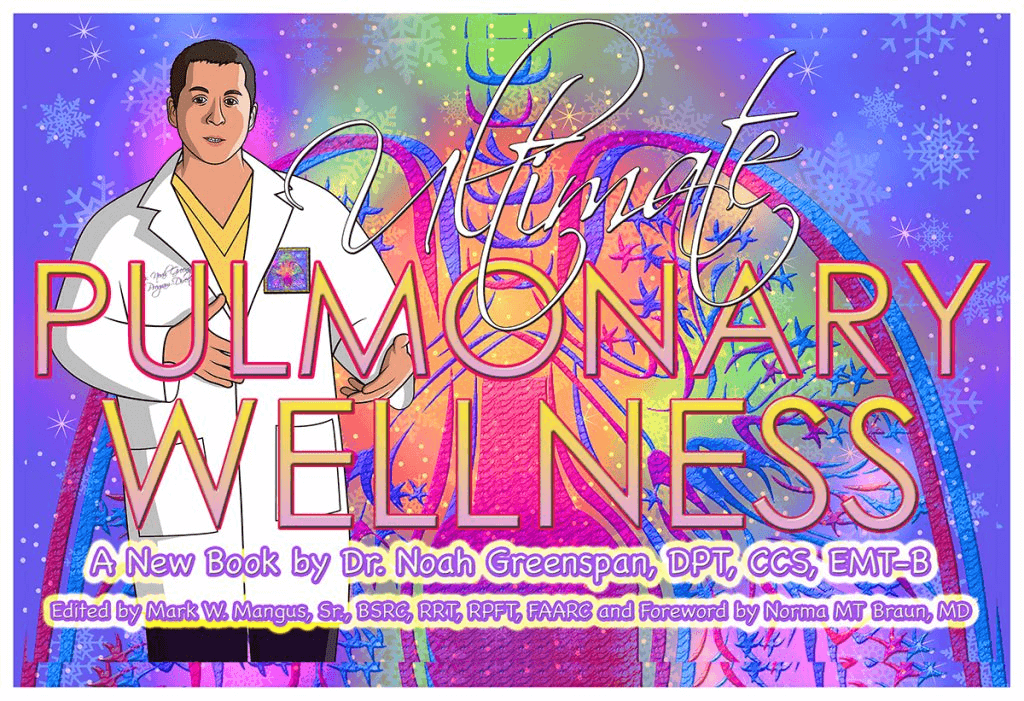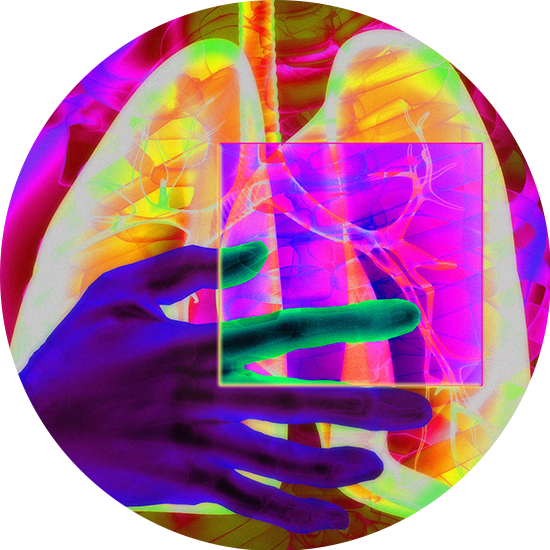
Prevention of Infection
Noah Greenspan, PT, DPT, CCS, EMT-B
“An ounce of prevention is worth a pound of cure.” – Ben Franklin
Living with a chronic illness, particularly a respiratory condition can significantly compromise your immune system, making you more susceptible to picking up a bug, catching a cold or developing an infection or exacerbation of your existing pulmonary condition. Patients often report getting sick once, twice, three times or more over the course of a given year and whether it is a cold, the flu, pneumonia, or an exacerbation, it always seems to settle in the chest.
Frequent illnesses or exacerbations, or even one bad one, can impact the progression of your disease and its associated symptoms. For this reason, it is crucial not only to take care of yourself when you get sick, but also, that you take specific measures to PREVENT yourself from getting sick in the first place.
One thing that is important to realize is that even if you do everything right, you can still get sick anyway. However, our goals are to decrease the probability of your getting sick in the first place, increase your ability to fight off and recover from illness, and reduce the severity of that illness, when you do get sick, minimizing its impact on your life.
How We Get Sick
At the most basic level, disease is caused by pathogens. The most encountered pathogens are bacterial, viral, fungal, or parasitic in origin. The most common routes of transmission include airborne or inhaled, direct contact, indirect contact or contact with a contaminated surface, sexual contact, contact with infected blood or body fluids, and the fecal-oral route.
Viruses and bacteria cause most respiratory infections and unless you are living in a bubble, you will likely encounter one (or a million) of these daily. They are introduced to our bodies, through the mucus membranes of the eyes, nose, and mouth, either by inhaling them or by touching or coming into contact with a contaminated surface, and then touching your face.
We are also exposed to, and come into contact with spaces, surfaces and objects that are exposed to and contacted by many people daily. Anything that is touched by many people, many times each day has a greater chance of being contaminated with bacteria, viruses, and other pathogens.
Depending upon the type of organism and the surface on which they are found, some viruses and bacteria can live outside the body for up to 24 hours. Whether or not you get sick depends upon the specific virus or bacteria and the status of your own immune system.
Please understand that I am not trying to scare you into hermetically sealing yourself in bubble wrap. What I am trying to do is raise your awareness of everyday potential exposures so you can better protect yourself against them. Here are some suggestions on how to do that:
“Don’t Patchke Your Face”
My Grandma Peppie used to say: “don’t patchke your face.” Patchke is a Yiddish word that means to play around or fiddle with. It was good advice then and it’s good advice now. As I mentioned previously, pathogens are introduced to our bodies, through the mucus membranes of the eyes, nose, and mouth. So don’t fiddle.
Wash your Hands (a lot)!
This goes hand in hand (pun intended) with “don’t patchke your face.” Frequent hand washing is your single best defense against introducing viruses or bacteria into your system. Most of us know (or should know) that we’re supposed to wash our hands before we eat, or after we use the bathroom. However, that’s not adequate, particularly for someone living with a pulmonary disease. You really need to be washing your hands every time you come in contact with a potential source of infection.
Also, to be clear, when we talk about hand washing that does not just mean a quick rinse. Effective hand washing means using soap and water, and rubbing your hands together vigorously, for at least 30 seconds. Keeping in mind that you initially turned the water on with dirty hands, turn it off using a paper towel so that you don’t contact those germs again. The same goes for the bathroom door.
Antibacterial Gels/Creams/Lotions
If you don’t have access to soap and water, carrying a small bottle of anti-bacterial gel, cream, or lotion can come in “handy”. Some people may argue against using anti-bacterial products, on the grounds that they kill the good bacteria along with the bad. While this may be true to some degree, I would still choose using an anti-bacterial gel over walking around with the common cold or pneumonia or Covid on my hands, just waiting for an opportunity to enter my mucus membranes.
Antibacterial Sprays and Wipes
Remember also that objects or surfaces that you come in contact with may not be cleaned frequently (or ever), and therefore, may be contaminated with a whole host of pathogens. For this reason, it is well worth your time and effort to spray or wipe them with disinfectant before you use them. As just one example, when you go to the supermarket, wipe down the shopping cart before leaning all over it or putting your food inside.
At the Pulmonary Wellness & Rehabilitation Center, we have dispensers with anti-bacterial foam for our patients and staff. We also wipe down every machine in between every patient. The last thing we want is for people to get sick at a wellness center.
Protect Your Home
When you return home after a day out, you carry with you all of those nasty ‘bugs’ (bacteria and viruses) that have latched onto you and your belongings over the course of your day. You can help minimize their impact and reduce the likelihood of contaminating your home by taking a few precautionary measures.
First, as previously mentioned, wash your hands as soon as you walk in the door, and even better, take a shower. Change out of your dirty “outside clothes,” and into your clean “inside clothes,” and swap outside shoes for inside shoes or slippers.
When visitors enter your home, ask them to take similar precautions. Well, maybe not the shower part, but they can certainly take off their coats in the hallway, remove their shoes at the door, and wash their hands when they arrive. This is even more important when children are visiting. Since children are much more likely to come in contact with dirt, viruses, and bacteria, it would be to everyone’s advantage if they have an extra set of clothes to change into and immediately wash up, especially after they’ve been playing outside.
Protect Your Property (O2 Equipment and Supplies)
If you use oxygen, it is important to protect all your supplies and equipment including the tank or concentrator itself as well as all the accessories including tubing, masks, and cannulas. All the bugs that can travel with you on your clothes and your property, can also travel on your oxygen equipment. Be aware of where you place your equipment both at home and when you are out and wipe it down frequently with an antibacterial wipe, especially when returning home. With respect to your cannula or mask, be sure to place them on something clean when not in use and wipe them down if they have been sitting for a while. I can’t tell you how many times, I have seen people’s cannula hanging on the floor or thrown into their bag unprotected. If you keep it in a plastic bag, wipe it down BEFORE you put it in the bag and…wipe down the bag.
Be Aware of Your Surroundings
Equally important to being vigilant at home is minimizing your risk of exposure when you are out. As mentioned previously, this is particularly important when you are in public places that are regularly frequented by a lot of people.
Again, think about how many people’s hands touch the handrails on escalators or stairs, equipment at the gym, door handles or push buttons. I’ll give you a hint. It’s a lot. And the poles on buses and subways are virtual petri dishes for every disease known to man and probably a few yet-undiscovered ones as well.
And then…there’s the doctor’s office. Now, that’s a whole ‘nother ball of bacteria (and viruses). Besides the obvious, coming-in-contact-with-a-high concentration-of-sick-people-in-one-place, how often do they clean the tables and chairs? And what about that annoying pen on a chain? Or even the magazines? If in doubt, don’t be afraid to confirm that the area and equipment have been disinfected. While this may seem like an imposition on the staff, as healthcare professionals they should appreciate your concern and understand that it’s better to be safe than sorry (or sick). As Ron Reagan said: “Trust but verify.”
Dining Out
Dining out comes with its own unique risks of exposure to bacteria and viruses at every stage of the process, from the food preparation to its distribution, to its consumption. Every person, from the host or hostess to the chef, to the server, and every item from the table, to the menus, to the plates and utensils, to the food itself is a potential source of contamination. A weak link in any of these areas can increase your risk of exposure and illness. I don’t know about you, but if I go into a restaurant and my server is sick, I simply excuse myself, leave a tip, and make it my business to get the heck out of there as fast as I can.
Other Factors
You can’t make the whole world germ-free. However, you can do your best to protect yourself. Here are some other suggestions:
Stay Away from Sick People
That may sound overly simplistic, or even harsh in some cases, but it is both completely true and very important. Of course, we understand that you want to see your friends and family, but trust me, if your children are sick (or even your grandchildren), it is much better to take a rain check—for everyone. As someone with a chronic pulmonary disease, a cold for you is not the same as a cold for someone with a healthy immune system, and as heartbreaking as it might be to skip the visit; you really must look at the big picture. If that visit lands you in the hospital, it doesn’t do anyone any good.
Stay at Home When You’re Sick
Rule Number One: if you are sick, just stay home! We are conditioned to believe that we should never, ever, ever miss a day of work. However, that is a surefire way to prolong your illness and maximize its spread to as many people…and places…and surfaces as possible.
At the Center, our policy is if you are sick, you stay home, no if’s, and’s or but’s. This applies to patients and staff alike, even if you feel well enough to exercise or come to work. Again, the last thing we want is for you to get sick at a wellness center or for you to get someone else sick at a wellness center (or anywhere else).
Get the Flu Shot
Many people ask whether they should get the flu shot. While there is no single best answer for everyone, the Center for Disease Control recommends that everyone 6 months or over should get the flu shot annually. This is especially true for people over 65, or anyone with a medical condition that could compromise their immune system such as respiratory and cardiovascular disease. However, individual cases will vary depending on age, level of risk, medical condition(s), and doctor preference, among other factors, so to be sure, check with your personal physician.
Get the Pneumonia Vaccine
Like the flu shot, there is no single best answer for everyone and again, individual situations will vary, so to be sure, please consult your personal physician. Up until recently, it was generally recommended that people over 65, or anyone with a medical condition that could compromise their immune system, get a one-time, single-dose vaccine, called the “pneumococcal polysaccharide vaccine 23 (PPSV23). However, based upon the findings of a large clinical trial, that recommendation has changed. At the time of this writing, the CDC recommendations are as follows:
- In addition to a single dose of PPSV23, at-risk individuals, 65 years of age or older, should also get a dose of the pneumococcal conjugate vaccine 13 (PCV13), which provides protection against community-acquired pneumococcal pneumonia and other pneumonia infections.
- People who have never had the pneumonia vaccine should get the PCV13 FIRST and get the PPSV23 six to twelve months later.
- People who have already had the PPSV23 should also have the PCV13 if it has been at least one year since their initial vaccination with PPSV23.
Get the Covid-19 Vaccine
At the time of this writing, most adults are on our first round of boosters for Covid-19 and children have begun getting their first doses. As a novel coronavirus that is still surging in many parts of the world, I am sure this situation will continue to evolve. Speak with your physician and continue to follow the latest guidelines from the CDC, NIH and WHO.
Get Enough Rest
Sleep affects every system of the body, from the immune to the endocrine, to the cardiovascular and pulmonary, and every other system in between, to some degree or another. Lack of sleep or not getting enough overall rest can have a negative impact on your body’s immune system, lowering your body’s resistance and its ability to defend itself against bacteria and viruses. While most guidelines recommend between 7 and 9 hours, the exact amount of sleep we need varies from individual to individual.
Don’t Smoke!
Cigarette smoking is one of the worst possible things you can do to your body. As if causing heart disease, lung disease, cancer and complications during pregnancy weren’t enough, smoking cigarettes also lowers your body’s immune function and increases your chances of developing an infection or exacerbation. So just don’t do it.
Avoid Triggers
In addition to bacteria, viruses and other pathogens that can make you sick, there are other substances and conditions that can act as “triggers.” These triggers can cause a range of symptoms including irritation of the eyes, nose or throat, cough, tightness in the chest, shortness of breath, or inflammation of the airways and lungs. All these mechanisms of the inflammatory process can make you more susceptible to developing an illness or exacerbation.
Triggers can be more universal in scale like air pollution or weather, or they can be more personal and individualized like encountering a strong odor or cigarette smoke. Here are some of the more common triggers that can particularly affect people with respiratory disease:
Indoor Allergens
Indoor Allergens include things like dust, mold, cockroaches and roach droppings, and pets and animal dander, among others. Symptoms can include, coughing, sneezing, stuffy or runny nose, as well as itching, burning or tightness in the ears, eyes, nose, mouth, throat, or chest. In these situations, it is crucial to eliminate the source of exposure, whenever possible OR to remove yourself from the exposure. This can be difficult in each of the above situations, for various reasons. However, the longer time that you are exposed and the more intense the exposure, the greater the chances are and the greater the potential damage that you are likely to experience.
Outdoor Allergens
Outdoor Allergens include things like pollen, trees, grass, weeds, and mold, among others. Like indoor allergens, symptoms can include, coughing, sneezing, stuffy or runny nose, as well as itching, burning or tightness in the ears, eyes, nose, mouth, throat, or chest. These allergies will likely be greatest from the spring through the fall and your best bet is to avoid exposure as best you can. If you are exposed, treat it similarly to exposure to a virus or bacteria by washing your hands frequently and changing your clothes and showering when you come back home. Saline eyewashes may be beneficial as well as nasal and oral saline rinses. Pay attention to the local pollen and other allergen counts and speak with your doctor about any over the counter or prescription medications that might be helpful.
Pollution
People living in more industrialized, densely populated urban areas will likely be more exposed to pollution than those that live in areas that are more rural, sparsely populated and less industrial. Air pollution includes various gases, ozone in particular, smoke, haze, smog, and ash, among others. Depending upon where you live and the type of pollutants, the conditions can change seasonally, daily, or even over the course of a single day. In the case of environmental incidents or emergencies, conditions can change rapidly and dramatically.
Pollution will typically be worst on hot, humid days in the city. The Environmental Protection Agency (EPA) reports the Air Quality Index (AQI), which measures air quality based upon 5 pollutants: ground level ozone, particle pollution, carbon monoxide (CO), sulfur dioxide (SO2), and nitrogen dioxide (NO2). It is ground-level ozone and airborne particulate pollution that pose the greatest threat to humans (and animals), particularly, those in high-risk groups, like respiratory disease.
Check the AQI at www.airnow.gov if you plan on being outside for any significant period. On days when the air quality is poor (greater than 100), consider limiting your time outdoors and avoid strenuous activity. Since ozone is generally higher in the afternoon and evening, try to organize your day, accordingly, going out in the morning instead of later in the day.
Occupational Exposure
Certain jobs, hobbies and other activities will increase your chances of being exposed to one or more substances that can cause or worsen your respiratory condition. These include toxic chemicals and other irritants such as smoke, asbestos, dust, dirt, and debris, among many others. Ideally, you will be able to avoid this type of work but if this is not possible, be sure to be aware of and use maximum personal protection equipment (PPE) for the type and level of risk involved. This includes protective masks, gowns, gloves as well as any other specific protective gear for the task at hand.
Weather
Many people are affected by weather, particularly, either by heat and humidity or by cold, dry air. When it is hot and humid outside, the air seems to be thicker and heavier. As a result, people with respiratory disease are forced to work harder with each breath to move air in and out. When it is particularly hot and humid, try to go out early in the morning before the sun is at its strongest or in the late afternoon or evening, after the sun has begun to go down.
On cold, dry days, the airways can become narrower due to bronchoconstriction and spasm of the smooth muscle lining the airways. Ask your doctor if you can take your rescue inhaler or nebulizer about 15 minutes before going out. Also, cover your nose and mouth with a scarf, mask or other product that can help warm the incoming air.
Other Exposures
There are other exposures that are more personal, individual, or situational in nature and while I can’t possibly name them all, here are a few examples:
- Cigarette (or other) smoke
- Perfumes, colognes and other scented oils or lotions
- Air fresheners, candles, and incense
- Construction
- Cleaning products
- Other
Again, I am not trying to scare the bejesus out of you. However, in many cases, depending upon the type, severity, and degree or intensity, one exposure can sometimes be enough to cause a problem, especially if you are already compromised in one way or another; to trigger inflammation or an exacerbation, or to get you sick. So, please take the extra time and effort to protect yourself and your loved ones.
Don’t Shake Hands or Kiss Hello and Goodbye
While it may be customary to shake hands when you meet someone, it is not in your best interest. Now, I’m not trying to be gross, but in most cases, you really have no idea when that person last washed their hands. In this situation, social mores must take a back seat to your health. The same goes for the hello and goodbye kiss and doubly so for the double kisses. You get the idea.
You can try using an alternative greeting: say “Namaste”, bow, wave, or salute each other. Hell, throwing up a gang sign (joke). Or you can simply let people know that you don’t shake hands. Whether or not you tell them the reason is up to you, but it could be a good teaching opportunity and a chance to educate others about your condition. The choice is yours. No pressure.
Throw Tissues Away Immediately After Use
This one may seem obvious, but I can’t tell you how many people I see blowing their nose and then putting the dirty tissue back in their pocket, purse, up their sleeve, or in their bra (or what I like to call: “Grandma’s tissue box”) …and don’t even get me started on the handkerchief! I don’t know who thought of this brilliant idea, but do you really want to save that stuff for later? Besides being a treasure trove of bacteria, they’re just gross. So don’t use one.
Void Confined Spaces
Whenever possible, avoid spending prolonged periods of time in small, enclosed spaces with poor ventilation. Try to stay in large, open, well-ventilated areas with lots of fresh air and where close contact with others is less intense.
As an example, airplanes are one of the worst possible places when it comes to the transmission of illnesses for a whole host of reasons. There are lots of people, in close proximity to each other. The air is re-circulated around the cabin and the surfaces are rarely disinfected. This makes it very easy for bacteria or viruses to travel from person to person, on surfaces or through the air. Although not quite as bad, the situation is similar in small offices, elevators, or other enclosed areas.
Suit Up
Let’s face it. Regardless of how well we attempt to prepare ourselves for every possible condition, we are all going to encounter situations in which we have no control over our environment. When all else fails and you find that you cannot control the environment or those around you, more extreme measures must be taken. Suit up. When we know we are going to be in a hostile environment, wearing a mask and/or gloves can be an effective last-ditch effort to avoid exposure.
Seek Medical Attention Sooner Rather Than Later
By now, you should realize that I believe in the “better safe than sorry”, “err on the side of caution,” and “an ounce of prevention…” schools of thought. When in doubt, seek medical attention sooner rather than later. As I have mentioned on many occasions, a cold is not the same for me as it is for you or someone with a respiratory disease; and a day or two, and sometimes even a few hours, can be the difference between preventing and minimizing the impact of a problem versus really getting in trouble. Many doctors will give their patients a prescription for antibiotics and/or steroids to keep on hand for when they do get sick.
Other Suggestions
Recently, I asked the members of my Ultimate Pulmonary Wellness Facebook group to share some of their own personal practices for preventing infection. Here are some of their suggestions:
- Use antioxidant vitamins, minerals, and herbs; particularly, vitamin C, zinc, Echinacea, and green teas
- Use immune-boosting products like “Airborne,” “Emergen-C,” or NUUN.
- Use gut health-enhancing probiotics
- Use nasal rinses and throat gargles
- Use an air filter/purifier
Order Your Book Now!

Purchase Your Signed Copy Today!
- Within the United States: $27.50 including Postage and Handling!
- Outside of the US: $52.00 including Postage and Handling! (Sorry. We know that is more than the cost of the book but we cannot ship for less.)
Subscribe To Our Newsletter For Upcoming Offers
- Be the first to know about new webinars, exclusive offers, and podcasts.
























